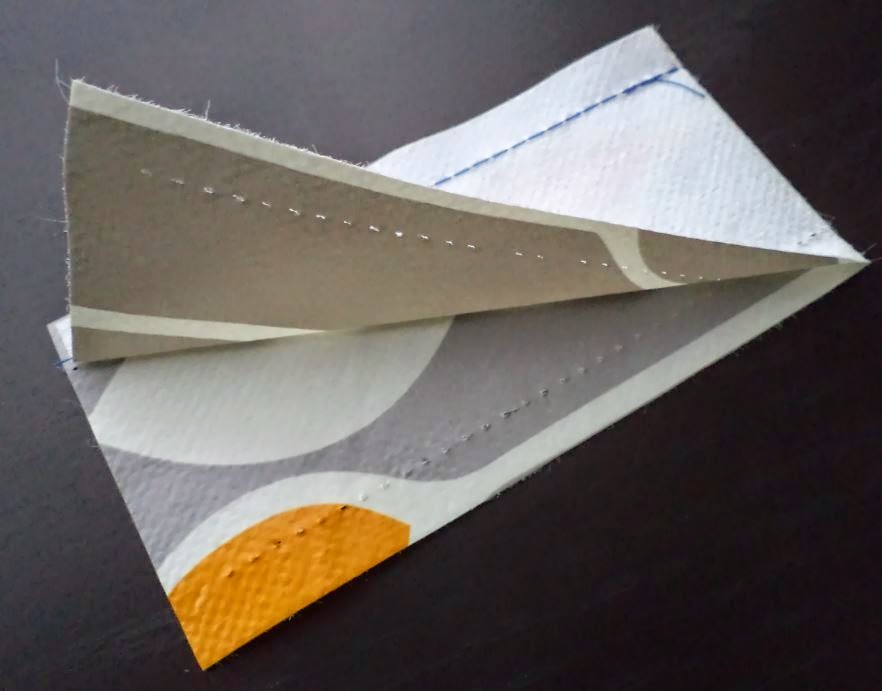 |
| Three metres of waxcloth for $3! |
I want to talk about scoring the three metres of discontinued waxcloth (really wide, too: 54 inches) that you see here, for a grand total of $3.15! At regular price, it would have been $13.62... not that I would have paid that because I wouldn't have purchased it. I have never sewn with waxcloth before, so until I saw this "too good to pass up" dollar per metre price, it really hadn't occurred to me to consider crafting with it.
Well, maybe that's not entirely true. Using some sort of waterproof material had always been in the back of my mind for my passport organizer and toiletry case projects, but I didn't want to commit.
But now that I have these funky supplies on hand — which were so cheap as to be throwaway — I think I'll take the plunge and make something out of waxcloth.
So what exactly is this stuff? Apparently it's "whatever" material (cotton, canvas, etc.) that's been treated with paraffin wax prior to being woven into a fabric. It's essentially a water-proofing technique from the old days. It has a bit of a vinyl-ly feel, but is thin enough that I don't think it'll be difficult to work with. The online Oxford dictionary defines waxcloth as "cloth that is impregnated with oil for covering floors and tables; oilcloth". To be honest, I'm a bit fuzzy as I have seen waxcloth/oilcloth and laminated cottons described to the point where I'm not exactly sure what I have... other than that the store labelled what I bought as "waxcloth". (Although it's not a fabric store and they also had clear vinyls hanging on the same racks.)
Anyway, here it is sewn together.
It was easy to sew and did not pose any problems. Here I've picked open one of the seams to show what will be an issue, however: mistakes. They may wind up being costly because stitching holes will not close up like with regular fabric (and in fact, may act as "perforation points").
Here is the item turned right side out to show the finished seam. I used a longer stitch length than normal to prevent the seam from being pulled apart easily (i.e., the "perforation" thing again).
And finally, I decided to sew on the right side of the fabric to see if I could "feel" any appreciable difference and am happy to report that I had no issues again. The material fed perfectly fine without using a special presser foot.
I'm now looking forward to making an actual "something" out of this waxcloth. (The hard part will be to decide what exactly...) Several of the simple projects that I've made in the past could easily be done with this stuff.
If you're now similarly inspired, this laminated toiletry travel bag from Sew4Home (another great sewing resource, by the way) might be a good starter project.






Great score on the wax cloth, Rochelle! I haven't sewn with it before and I would only be concerned about the goofs and making holes.
ReplyDeleteI'm sick at home today and reading your blog, and stumbled upon this post via link in another post discussing durability issues with this fabric, so pardon the comment on a really old post!
ReplyDeleteThis fabric, as you've likely discovered by now, is NOT, in fact waxcloth OR oilcloth. It is a thin plastic-y or vinyl-y substance of some kind over a paper-y backing, and is not remotely durable as you now know for use in anything other than eventually disposable table cloths, place mats, or floorcloths and the like, and is actually rather tear-able. The low price should've been a dead giveaway that this is not really "fabric" in the traditional sense (you get what you pay for!).
Waxcloth is often made of cotton fabric or canvas that has been treated with a wax coating so as to render it water-resistant (though usually not totally water-proof), and is an old-time-y method used before wearable plastics came into being. Oilcloth, at least the material found in fabric shops today, has a plastic/vinyl layer over a fabric backing, and is waterproof. When oilcloth is sewn, however, it loses its waterproofing because of the holes created by the needle; you can use a seam sealant (usually in tape form) to seal those holes is you want something to be waterproof. Both of these types of fabrics are usually very durable,and oilcloth especially is difficult to tear.
Both if these fabrics are rather pricey, especially waxcloth, and you'd never find a deal in them the way you did with the stuff that's the subject if this post, unless the shop was having a fire sale or going out of business, and even then I doubt it'd be priced that low!
The stuff you bought is quite cute but durability is an issue as you now know. You can use it to make table or picnic cloths from, or even gift bags for lightweight items. A friend of mine just yesterday gave me my Christmas present in a gift bag made of this type material. If you have an Etsy shop, you could sell them as a more-durable-than-paper gift bags!
Right on all counts! I've determined that it's fine if used as a "wipe clean" lining for something, if incorporated with other fabrics within a project (like my Bindle Bag), or made into light use items like I've described in other posts (file folders, a tablet case, even flowers).
DeleteThank you for visiting and thanks especially for taking the time to add to the discussion!